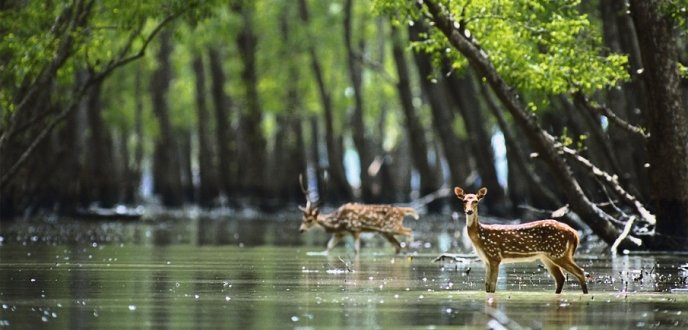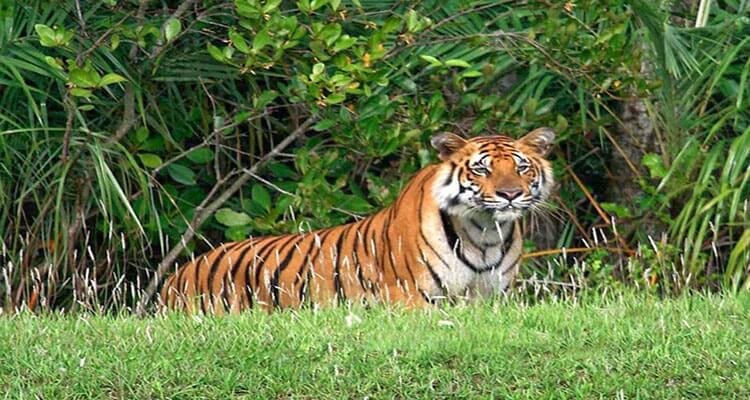Bangladesh, a terrain. Most of which are the rivers and rivers. However, forests in the southern part It is called "mangrove forest". But there's a nice name. The name Sundarbans is named in the name of "Sundari" tree in the forest. Although the name "Sunderiban" was more reasonable! This is the beautiful Sundarbans decorated this writing.
History of the Sundarbans
During the Mughal period a local king took the lease of the Sundarbans. After getting the copyright from the Mughal emperor Alamgir II in 1757, the Sundarbans area was created by the East India Company. The forest area is under organizational management since the establishment of forest department in India's then Bengal province in 1860 AD.
At the beginning of the eighteenth century, the size of the Sundarbans was nearly twice the present. Human pressure on the forest is increasingly increasing its size. In 1828 the British government received the title of the Sundarbans. In 1829, he conducted the first survey work of the Sundarbans. Hijage In 1878, the entire Sundarbans area was declared as reserve forest and in 1879 the responsibility of the entire Sundarbans was entrusted to forest department. The name of the first divisional forest officer of the Sundarbans is M. U. Green In 1884 he served as the Divisional Forest Officer of the Sundarbans. During the partition of India in 1947, 6,017 sq km of Bangladesh in the Sundarbans Which is about 4.2% of the total area of Bangladesh and about 44% of the entire forest area.
The legal rights of the first forest management department were established on Sundarbans in 1869. According to Forest Act (Section 8) of 1965, a large part of the Sundarbans was declared as reserved forest in 1875-76. Within the next year, the remaining part is also recognized for the reserve forest. This resulted in the control of forest department under the control of the remote civil administration. Later, in 1879, forest department was established as the administrative unit for forest management, with its headquarters in Khulna. For the Sundarbans, during the 1893-98 period, the first forest management plan was enacted.
The total area of the reservoir, including the reservoir, is estimated at 6,526 square miles (16,902 km).
The Sundarbans in the statistics
A Bangladesh Forest Department statistics show that in 2004, a survey was conducted based on the footprint of the tiger with the help of UNDP, Bangladesh and India experts. The number of tigers in the Sundarbans was 440. Of these, male tigers are 121, mother tigers 298, and 21 children. After 10 years, joint survey of Bangladesh-India, using the capture camera from April 2013 to March 2015, with the help of the Wildlife Institute of India, funded by the World Bank-assisted Strengthening Regional Co-operation for Wildlife Protection Project. Doctor Jhala and Qureshi participated in the survey work for technical assistance from India. According to the survey, in the Sundarbans Bangladesh part, there are 106 tigers in the 6, 17 sq km, which is less than one-fourth of the survey of 10 years ago.
Besides, deer 100,000-150,000; Monkeys 40,000-50,000; Wild pigs 20,000-25,000; Crocodile 150-200; O Cats 20,000-25,000; And many other animals exist. Besides, in the case of trees, 51.70% of the forest is the main tree of the Sundarbans. About 16% of the area contains live trees. Apart from these, there are many different types of trees including cattle, gourds, keora, Dhundul, Khalsi and many other trees.
Sundarban tree tree
The Sundarbans is very nice to know some of the trees inside the trees -
Sundari Sundari Sundarban main tree. This tree of 15-17 meters height is very durable, sturdy and heavy. Good as a beautiful tree fuel used to build caves, boats, furniture, house poles, electric pillars etc. Sundari tree Sundarbans East Zone, Sundarbans Eastern Forest Department, Sharnkhola range of Bagerhat district, Chandpai range and Sundarban West Forest Department Khulna range, Sundariya range beautiful trees are found.
Animal is one of the most valuable trees in the forest. A river named after this tree has been named. Its expanse of river bank canal in the more lonely area of the forest. These trees, which are used for making boats, furniture, house poles, electric poles etc., are now completely prohibited. Under the soil, wood is not destroyed in hundred years. So the rail line is widely used. It is also important as a fossil of forest. The animals are found in almost all places of the Sundarbans. However, animal trees are found in Satkhira ranges of Sundarban West Forest Division.
Gowa: The Sundarbans' most growing plants This tree is highest 13 meters high. Its stems and wood are quite soft. The main use of Gaya was as raw material of Khulna Newsprint Mill. There is also considerable use of packing boxes, daisals, poles, pencils, drums, tabla and toys. Its bark is regarded as fuel. Gewa Flowers are the main source of honey. Its kiapita and fruit deer food. Gowa's white-colored glue is highly toxic. Vision energy may be lost if people notice it.
Garning the bush bushes the national plant. Its wood is used as one of the best fuels. Medium high altitudes (3-5 meters) are used as a solid wood-clay palette. Almost all of the forests are seen as lesser grains. Tigers like this hideous bushes as the place to hide. This kind of medicinal quality is used to make the color of the bark, to paint the nets and tanning the skin. One of the Sunderbans one of the economical plants wasted. The accumulation of grains from the Sundarbans of Siddar is closed. The Sunderbans are very much grown in the seashore area.
This post has received a 0.09 % upvote from @drotto thanks to: @mdhasanpintu.
Sundarbans our mangrove forest. It is so beautiful. We are proud that we have it.
it is very beautiful place in bangladesh.